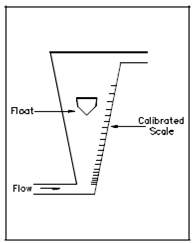Rotameter:
The rotameter, described in Figure, is an area flow meter so named since a rotating float is the indicating element.
The rotameter consists of a metal float and a conical glass tube, constructed like in which the diameter rise along with height. While there is no fluid passing by the rotameter, a float rests at the bottom of the tube. As fluid enters the tube, the higher density of the float will cause the float to remain on the bottom. The space among the float and the tube permits for flow past the float. As flow increases in the tube, the pressure drop increases. While the pressure drop is enough, the float will rise to denote the amount of flow. The higher the flow rate the greater the pressure drop. A higher the pressure drop the farther up the tube the float raises.

Figure: Rotameter
The float should stay at a constant position at a constant flow rate. Within a smooth float, fluctuations appear even while flow is constant. Through using a float along with slanted slots cut in the head, a float manages a constant position along with respect to flow rate. That type of flow meter is commonly used to measure low flow rates.